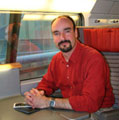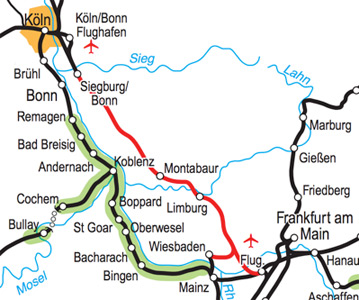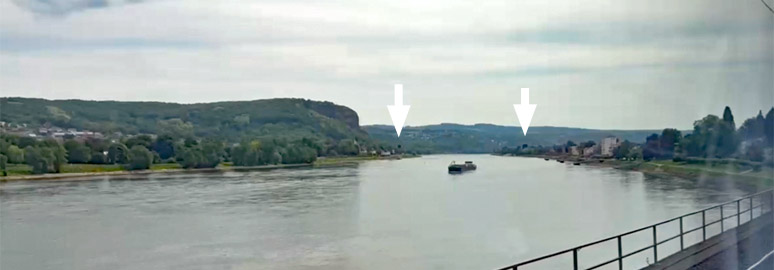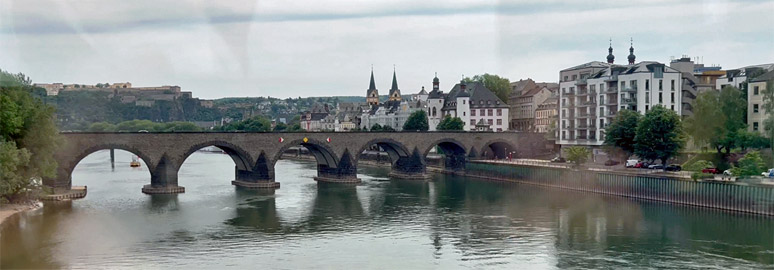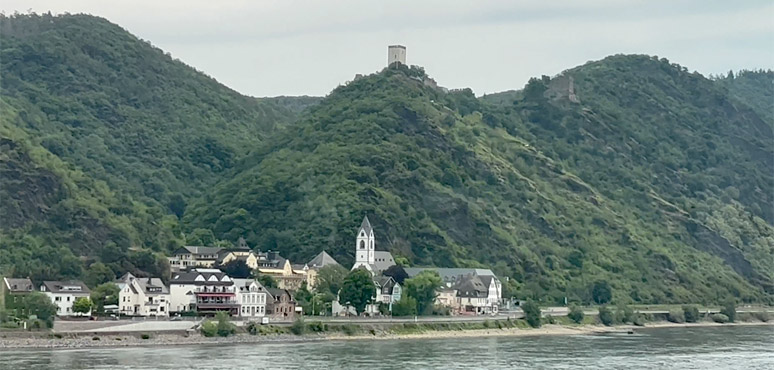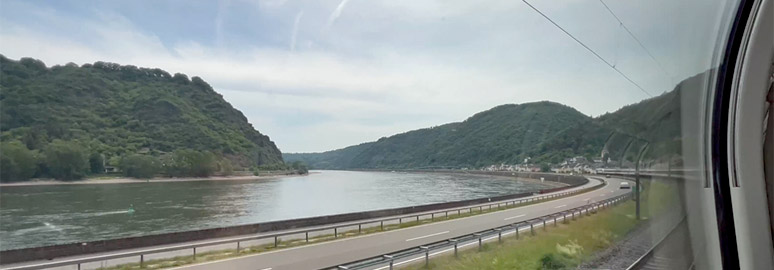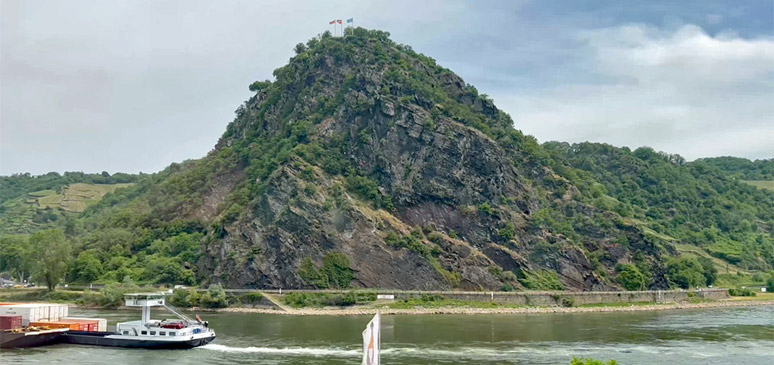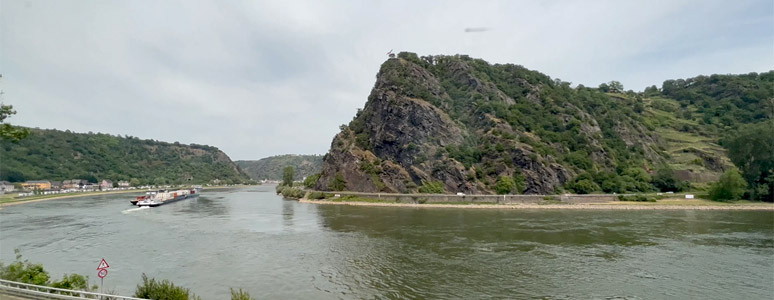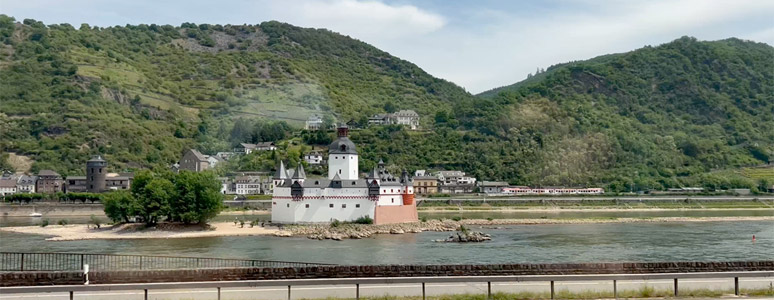High-speed? Or the scenic route?
When you travel between Amsterdam, Brussels or Cologne in the north and Frankfurt, Munich, Switzerland or Austria in the south, you have a choice. The fastest route is via the Cologne-Frankfurt high-speed line which opened in 2002, shown in red on the map below. But the more scenic way is to take the original curvaceous railway along the Rhine Valley, past cruise boats, barges, vineyards, hilltop castles and the legendary Lorelei Rock. On the map below, scenic routes are highlighted in green. The slower Rhine Valley route takes an extra hour, but I think it's time well spent. Watch the video!
To buy tickets via the Rhine Valley
-
By default, journey planners assume you want the fastest route and will normally send you via the modern high-speed line. If you want to travel via the slower Rhine Valley line, simply enter 'Koblenz Hbf' as a stopover with length of stay left as zero.
-
All the best train booking websites allow you to specify a via station. Using the German Railways website int.bahn.de, click Stopovers, enter Koblenz Hbf, leave length of stay as zero. Using www.raileurope.com click More options. Using www.thetrainline.com click via.
-
If a train calls at Koblenz, then it's using the classic Rhine Valley route not the high-speed line, as you can see from the map above. All the trains using this route call at Koblenz. Even though there's now a high-speed line, some fast comfortable Intercity (IC) and even ICE trains still run via the classic Rhine Valley route every hour. You can reach Switzerland or western Austria this way.
Which side of the train to sit?
-
There's a railway on both sides of the river for much of the Rhine Valley route, but the main line runs on the west bank. So the river is on the left-hand side going south, right-hand side going north.
-
You can't usually specify a side when reserving seats, as the reservation system knows the carriage seat layout, but doesn't know which way round that car will be when marshalled in the train. But as German train are reservation optional not all-reserved, you can always move to any unreserved empty seats on the side of the train nearest the Rhine. Little LED displays above each seat (or little paper tickets, on old-school trains) show which seats are reserved and which are free.
-
The Nightjet sleeper train between Düsseldorf, Cologne and Munich, Innsbruck & Vienna uses the Rhine Valley route, although how much you see will depend on the hours of daylight at that time of year or (in the evening going southbound) whether it's a full moon or not. The photos below were taken from this sleeper train, on a summer morning northbound.
Exploring the Rhine by train & boat
-
This page is about making an inter-city journey via the scenic Rhine Valley route instead of using the faster high-speed line. But you can of course stop off and explore the towns of the Rhine by train, using regional trains that call at all stations. Simply use the German Railways website to check times and prices, int.bahn.de. The line along the Moselle from Koblenz to Cochem & Bullay is scenic too!
-
You can also cruise the Rhine. The Köln-Düsseldorfer Line has regular scheduled river sailings from Cologne to Rüdesheim between May to October, with various other sailings on various dates between Cologne, Koblenz and Mainz, see www.k-d.com. You can go one way by boat and the other by train, making an excellent day out from Cologne or Koblenz.
Along the Rhine in pictures
Here are some photos of a journey down the Rhine, ordered assuming you're travelling south. Although most of these were in fact taken from an early-morning northbound run down the Rhine on the Innsbruck-Cologne Nightjet - who says you miss all the scenery on a sleeper train!
Cologne to Bonn
Mainline trains leave Cologne Hbf (Köln Hbf in German) and about 19 minutes later call at Bonn. The line starts running along the river shortly after Bonn.
The Bridge at Remagen
Between Bonn & Koblenz you'll pass Remagen, non-stop if you're on a fast train. You may have seen the 1969 film The Bridge at Remagen, about a key crossing of the Rhine captured almost intact by the Americans in March 1945, see en.wikipedia.org/wiki/Battle_of_Remagen. Your train sweeps round a bend to the left here (going south) before passing non-stop through the town, but as you can see in the photo below taken on the bend just north of the town. there's no bridge here today. The Ludendorf Bridge eventually collapsed after extensive bombing and shelling and was never rebuilt. However, the towers at each end of the bridge remain and the western end has been turned into the Remagen Bridge Peace Museum, www.bruecke-remagen.de. You can just see the towers, dark shapes marked by the white arrows in the photo below.
Koblenz
Shortly before arriving at Koblenz Hbf the train crosses the river Moselle, which flows into the Rhine here.
Koblenz southwards
Around 34 minutes from Bonn, the train calls at Koblenz. If you want to explore the Rhine Valley more, this is arguably the base from which to do it. The most scenic part of the Rhine Valley is from Koblenz to Mainz.
Kamp-Bornhofen & the Hostile Brothers
On the far bank just south of Boppard you'll see the little town of Kamp-Bornhofen (pictured below) with two castles above it, Schloss Sterrneberg & Schloss Liebenstein. For the legend of the hostile brothers, see www.castle-liebenstein.com.
The legendary Lorelei
Just south of Sankt Goar station (which mainline trains also usually pass non-stop) you'll pass the legendary Lorelei rock, on a difficult bend in the river for navigation. The Lorelei rock is quite distinctive, but you'll also see its name written on a white-painted square at it base, visible in the photo below. Read about the legend of the Lorelei at en.wikipedia.org/wiki/Lorelei.
Pfalzgrafenstein Castle
South of the Lorelei between Oberwesel & Bacharach you'll pass the Pfalzgrafenstein Castle on Falkenau island, a toll-collecting station dating from 1326 and one of the Rhine's most distinctive sights. Read more about it at en.wikipedia.org/wiki/Pfalzgrafenstein_Castle.
Watch the video
A journey from Cologne to Basel in the Swiss first class panorama car on EuroCity train EC9. Sadly this train swapped its panorama car for a regular Swiss seats car in 2024, and from December 2025 the Swiss EuroCity trains will use the high-speed line rather than this lovely Rhine Valley route.
